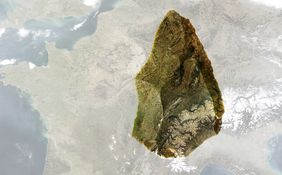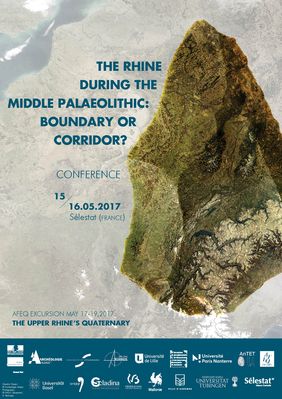- Accueil
- Actualités
- Le Rhin au Paléolithique moyen : frontière ou axe de circulation ?
Le Rhin au Paléolithique moyen : frontière ou axe de circulation ?
- Colloque - du 15.05.2017 au 16.05.2017 -

Un colloque international consacré au Paléolithique moyen dans la plaine rhénane sera organisé les 15 et 16 mai 2017, avec présentation de matériel archéologique français, suisse, belge et allemand.
Il sera suivi de trois jours d’excursion organisés par l’Association Française pour l'Étude du Quaternaire : "Le Quaternaire du Rhin supérieur (France, Allemagne, Suisse)".
CONFERENCE
The Rhine flows south to north in the heart of western Europe and therefore constitutes a major circulation axis linking northern and southern Europe.
Furthermore, the width and power of this major river, as well as changes of its flow type, may have blocked for some periods exchanges between both animal and human populations located on both sides. The role of the river – boundary or corridor – varied through time and is reflected by the archaeological material recovered from both sides of the river, reflecting a back and forth of a strong regionalism added to external influences.
Archaeological evidences suggest the river impacted human population since at least the Middle Palaeolithic. Particularly, techno-typological differences in the lithic assemblages composition allow to distinguish cultural areas centered on both eastern and western sides of the Rhine. However, the river does not appear as an impassable border as affinities have been noticed between some archaeological assemblages from Germany, France and Belgium.
This conference will bring together researchers from both sides of the Rhine and from various disciplines.
It aims at questioning the Middle Palaeolithic settlements through multiple scientific approaches for a better understanding the impact of the Rhine river on the human settlements, mobility and cultures.
The concerned area covers regions from both sides of the Rhine: Eastern France, Belgium, Western Germany, Luxembourg, and Northern Switzerland. This wide geographical setting will allow to cross-examine sites from both sides of the river as well as to integrate into the discussion data coming from both open-air and cave sites.
Chronologically speaking, the entire Middle Palaeolithic period (ca 300,000 - to 35,000 BP) will be discussed, from its older manifestations and roots in the Lower Palaeolithic up to the extinction of Neandertals and to the shift to the Upper Palaeolithic.
ORGANIZATION
The conference is organized by an international team from Archéologie Alsace (FR), Lille University (FR), CNRS laboratory AnTET (FR), Strasbourg University (FR), Tübingen University (DE), Basel University (CH) and Scladina Cave Archaeological Centre (BE), in connection with the work of the UISPP Commission on The Settlement Dynamics of the Middle Paleolithic and Middle Stone Age (PT).
With the financial support of DRAC Grand Est, Archéologie Alsace, AnTET laboratory, Tübingen University, Freiwillige Akademische Gesellschaft Basel, Lille University, Strasbourg University, Region Alsace and City of Sélestat.
Héloïse KOEHLER
heloise.koehler@archeologie.alsace
+33 6 23 54 73 00
Nicholas CONARD
nicholas.conard@uni-tuebingen.de
Kevin DI MODICA
kevin_dimodica@yahoo.fr
Agnès LAMOTTE
agnes.lamotte@univ-lille1.fr
Harald FLOSS
harald.floss@uni-tuebingen.de
Fabio WEGMUELLER
fabio.wegmueller@unibas.ch
LOCATION
Agence Culturelle d’Alsace
1 route de Marckolsheim
FR-67600 Sélestat
locate
AFEQ EXCURSION
The conference will be followed by a 3 days AFEQ excursion: “The Quaternary of the Upper Rhine (France, Germany, and Switzerland)”.
The fieldtrip will be held n French.
MAY, 17th
- Forêt de Haguenau, Betschdorf : transition plio-pléistocène
- Mutzig : dépôts de pente et occupation du Début-Glaciaire weichselien
- Achenheim : séries loessiques et cycles glaciaires
MAY, 18th
- Bergsee (D) : végétation et climat des derniers 35 000 ans
- Möhlin (CH) : dynamiques et impacts des glaciers régionaux
- Augst (CH) : point de vue sur les terrasses alluviales rhénanes et cité gallo-romaine
- Pulversheim : mines de potasse et histoire industrielle du Fossé rhénan
MAY, 19th
- Westhalten : agropastoralisme et orchidées
- Voegtlinshoffen : gisement paléolithique et histoire de la Préhistoire en Alsace
- Mussig : dynamiques alluviales holocènes du Ried
- Sélestat : une ville sur l'Ill

